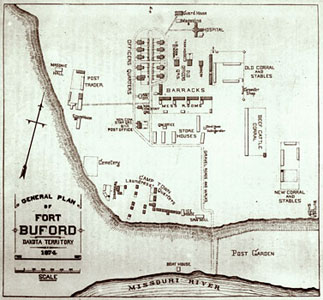
General Plan Map of Fort Buford 1874, SHSND# 474-007
Hazen later published a book about the northern Great Plains titled Our Barren Lands: The Interior of the United States West of the 100th Meridian and East of the Sierra Nevada. He cited details of rainfall, temperatures, and the records of climate experts for a period of eight years. He attacked Custer’s arguments one by one and mustered a letter from General Alfred Sully declaring the land of Dakota to be “high, dry, . . . unfit for cultivation.” He also refers to articles in the Bismarck Tribune in which the editor promises great production from local small farms and gardens. One of those gardeners was Colonel Lounsberry, editor of the Bismarck Tribune, who hired a horticulturist from Minnesota to manage his twenty acres and planted “200 raspberry plants, 100 currant bushes, a large number of Hyslop and Trancendent crabs, white willow cuttings, etc.” (Bismarck Tribune, 15 April 1874) Hazen asserts that Lounsberry harvested only 20 bushels of potatoes that year and others had even worse crops. Hazen concluded that “at Bismarck and in this vicinity, in spite of all the puffs and poetry of sanguine writers, the hard, naked fact remains, that it cannot raise anything like a supply even of vegetables – which, for the daily market, are being brought from the Red River, two hundred miles away. . . .” (p. 24 – 25)
Fort Buford eventually established a regular system of gardening along the banks of the Missouri River. A map of the post, drawn in 1893, shows a 100 acre garden between the post buildings and the river. (Remele, p. 72)




